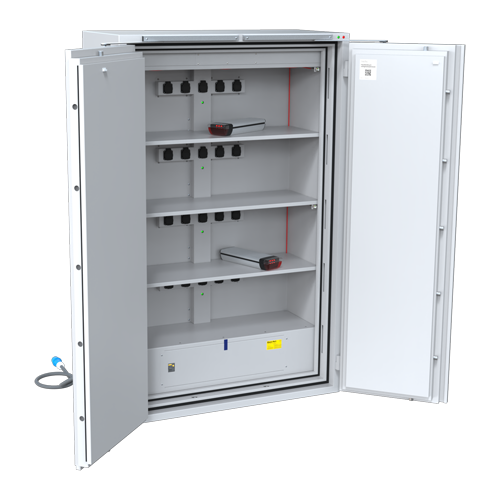How do you store lithium batteries?
GycxSolar provides a guide to safe lithium battery storage to help you ensure your batteries are stored under the proper physical and environmental conditions to extend their life. Due to the durability of lithium batteries, usually only a few minor adjustments are required to achieve effective long-term storage. Read below to learn how to become an expert in lithium battery storage!
Table of Contents

Common uses of lithium batteries
Lithium batteries are used in a wide range of devices in the workplace, such as computers, mobile phones, wireless tools, watches, cameras, flashlights, some medical devices, and in a variety of vehicles, such as golf carts, electric cars, and airplanes.
Batteries of all kinds have their importance, as they allow energy to be stored for emergency situations. However, the storage of energy is inherently risky, as batteries can overheat dangerously due to a phenomenon called “thermal runaway”.
This occurs when the temperature and pressure inside a battery cell rise faster than the heat can be dissipated. This phenomenon can be caused by a variety of factors, such as an external heat source, an internal short circuit, or other malfunctions. Fires caused by lithium batteries are difficult to extinguish and can release irritating and toxic fumes. Therefore, it is very important to understand how to store lithium batteries.
How to store lithium batteries safely?

Remove the battery and charge it
When it comes to battery storage, a key consideration is whether or not you need to separate the battery from its primary power system.
For example, you might think that if you store your golf cart, you are taking care of the battery. But this is not ideal. Even if you turn off the power to your golf cart, camper, or other vehicle, the battery will still naturally discharge at its inherent chemical rate.
If the battery is still connected, it will discharge faster, which may reduce its lifespan. Therefore, to protect your lithium battery pack and the equipment it is connected to, we recommend storing the battery separate from the equipment when the equipment is not in use for an extended period of time (usually more than 3 to 6 months).
If you plan to store your battery pack for an extended period of time, make sure to charge the battery to approximately 60% to 80% of its capacity. Because batteries naturally discharge over time, keeping track of when they were stored or last charged can be helpful in long-term battery management.
We recommend charging the lithium storage battery every three to five months. While many lithium battery chargers are equipped with safety features to prevent overcharging, it is not recommended to leave the battery connected to the charger for long periods of time.
Extra care is required when storing lithium-ion batteries. Lithium-ion batteries are a top choice for solar panel charging due to their rechargeable nature, but they are more expensive.
Proper storage of these batteries is also critical to protecting your investment from a cost-effectiveness and lifespan perspective.
Find the right storage area
The storage of batteries requires a suitable area, which can be considered from several factors such as space size, temperature, air humidity, light, charging conditions, etc. It is usually not difficult to find the right conditions to store these battery packs and protect them from damage.

Factors to consider when storing lithium batteries
Lithium-ion batteries have become a core component of portable electronic devices and renewable energy solutions. They are favored for their excellent energy density, low self-discharge rate and lack of memory effect. However, storage of lithium-ion batteries requires special care.
Proper storage methods not only ensure safety, but also protect your investment by extending the life of the battery and maintaining its performance. When it comes to understanding how to store lithium-ion batteries safely and efficiently, there are several key factors that are essential to maintaining the performance of the battery and extending its life.
Temperature
Temperature is a key factor in the storage safety of lithium-ion batteries.
Lithium-ion batteries are more adaptable to extreme temperatures than many traditional lead-acid batteries. But this does not mean that temperature management can be ignored.
The storage environment of lithium-ion batteries is critical to their safety and service life. These batteries should be stored in a cool and dry place, away from direct sunlight and heat sources. Extreme temperatures, whether too hot or too cold, will affect battery performance and may pose a safety hazard.
Lithium-ion batteries should ideally be stored between 35 and 90 degrees Fahrenheit. Whatever the temperature of the storage environment, try to keep the temperature as stable as possible.
Although lithium batteries are unlikely to suffer significant damage in non-extreme temperatures, it is best to store them at a suitable temperature to extend the battery life. Long-term storage outside the ideal temperature range may cause the battery to self-discharge faster, require more frequent maintenance, and may also shorten the battery life.

Batteries are very sensitive to extreme temperature conditions, whether it is too hot or too cold. The ideal storage temperature range for lithium batteries is 20°C to 25°C (68°F to 77°F), and the optimal storage temperature is 10°C (50°F). A stable and suitable temperature helps maintain the chemical stability of the battery and avoid premature aging.
Also avoid placing the battery in direct sunlight or near heat sources. The higher the storage temperature, the faster the battery will self-discharge.
High temperature may cause the internal pressure of the battery to increase, and the internal expansion will damage the battery structure, which will appear as a bulging battery from the outside.
Extremely low temperatures may reduce the battery’s charging efficiency. If your area has large temperature fluctuations, it is recommended to use a constant temperature and humidity space to storing lithium batteries.
In most cases, temperatures below freezing will not cause serious damage to lithium-ion batteries because they do not contain moisture. However, in order to avoid unnecessary risks, it is not recommended to store lithium-ion batteries in a sub-zero environment.
How to safely store lithium ion batteries? Please ensure that the storage temperature conditions are optimized.
Humidity

How to store lithium batteries at the right humidity?
When storing lithium batteries, controlling humidity is crucial, as a dry environment helps prevent corrosion of the battery terminals and potential short circuits. Exposing batteries to moisture is generally not a good idea, and the same principle applies to battery storage.
Although lithium batteries are designed with a sealed structure that can effectively block the intrusion of moisture, it is best to store them in a dry environment with low or no humidity.
If your area has high humidity, it may cause condensation to form between the terminals. If the resulting water droplets seep into the battery, they can damage the battery and increase the risk of a short circuit. In extreme cases, a short circuit can cause the battery to overheat or even catch fire. It is recommended to use a dehumidifier or desiccant in the storage area to reduce the effects of moisture on the battery.
Moisture can not only cause corrosion of battery contacts, but also cause short circuits. Therefore, ensuring that each battery terminal has an independent cover and taking all measures to prevent moisture intrusion is crucial to protecting lithium-ion batteries.
Therefore, in order to properly store lithium batteries, choose an environment with low humidity. Ideally, lithium-ion batteries are most suitable for storage in an environment with a relative humidity of 50%.
Illumination
How do you store lithium batteries when not in use?
When the battery is not in use, in addition to paying attention to the temperature and humidity of the storage environment, you should also pay attention to the light intensity. I believe you also have a basic understanding that long-term exposure to sunlight can easily accelerate aging due to ultraviolet rays, whether it is a person or an electronic product.
Although it is not necessary to keep lithium batteries in complete darkness, it is recommended to minimize exposure to prolonged light.
Prolonged exposure to direct sunlight may cause damage to the battery’s appearance and increase its temperature, which may affect the battery’s internal performance. Therefore, batteries should be kept away from direct exposure to strong or continuous sunlight as much as possible, and stored in a cool and dark place to reduce the risk of long-term damage.
Charging status

How to store lithium ion batteries safely? What is the most appropriate charging state of the battery?
First of all, you need to have a concept: all batteries will self-discharge during long-term storage.
The battery’s state of charge is a critical but often overlooked aspect of lithium-ion battery storage, especially when stored for long periods of time. Unlike some battery types, lithium-ion batteries should not be fully charged or fully discharged before storage.
During long-term storage, a fully charged lithium-ion battery may cause additional stress on its internal components and accelerate capacity loss. Similarly, if the battery is fully discharged before storage, it may suffer permanent damage.
Therefore, it is necessary to regularly check and adjust the charge level of lithium-ion batteries to the recommended range if they are planned to be stored for a long time.
Typically, a lithium-ion battery may self-discharge by about 5% within the first 24 hours after being fully charged, and 1-2% per month thereafter. If the battery is equipped with a safety circuit, this rate may be reduced to about 3%.
Ideally, the charge level of a stored lithium-ion battery should be maintained at 40-50% of capacity.
Ventilation
How to store lithium ion batteries when not in use? Lithium batteries should be stored in non-conductive and fire-resistant containers to further reduce safety risks.
When storing lithium battery packs, proper ventilation is a key point. If you place the battery indoors, there is an air conditioning or heating system to promote air circulation, which is equivalent to air exchange.
If you plan to store your batteries in a garage or storage shed, it is also important to maintain good air flow. This will help reduce dust particles and keep the air around the batteries fresh. Installing vents or screens, or leaving windows slightly open, can help prevent the air in your storage area from becoming stale or trapping too much heat.
Placement space
A common mistake when it comes to battery storage is not placing them in the right place.
First, avoid placing batteries directly on the ground or floor, as this can cause the batteries to overheat and self-discharge. Likewise, it is not recommended to place batteries on a table or other completely solid surface.
Ideally, batteries should be placed on a rack with vents or other ventilation designs so that air can circulate freely around the batteries.
Try to avoid using wire racks, as the batteries may short-circuit when in contact with metal. Consider purchasing commercial racks designed for batteries to ensure safe storage of battery packs.
Always keep the batteries away from any flammable items such as carpets, curtains, or wood. It is also recommended to have a fire extinguisher in the room where the lithium batteries are stored, just in case.
Keep it organized
When storing a small number of batteries, especially for home energy storage, organizing the space and placing them in an orderly manner is not the primary consideration.
But when you have multiple battery packs, especially rack-mounted lithium batteries and large energy storage systems, and when they are of different sizes or voltages, adopting an effective organization system will greatly facilitate management.
It is recommended that you classify the batteries according to their type and try to arrange them from old to new, so that you can track the battery usage more effectively. Classification is also beneficial to your space utilization. In addition, recording the relevant information of each battery, such as the production date, the last charging cycle, etc., will help you find the required battery quickly when needed. It also helps to maintain the battery more accurately.
Safe handling measures
How to take care of lithium batteries it’s already been explained clearly, but do you know what to do if it is not stored properly?
When handling batteries, always make sure your hands are clean and dry to avoid moisture and contaminants. When handling batteries, they should be handled with care to prevent any further physical damage. If multiple batteries need to be stored at the same time, they should be separated by non-conductive material separators to prevent accidental short circuits.
For batteries with exposed internal materials, it is recommended to use rubber caps or electrical tape to provide an additional layer of protection. Following these basic handling measures will not only help prevent accidents, but also maximize the remaining life of the battery.

If the lithium battery is damaged and the internal material leaks, emergency protective measures must be taken to prevent personnel from contacting the leaked material.
For lithium metal battery leakage, the leakage area should be evacuated immediately and only professionally trained personnel are allowed to handle the leakage site.
If the leak contacts the skin, immediately rinse with plenty of water for at least 15 minutes and seek medical treatment if necessary.
Avoid inhaling leaked gas or vapor. If someone is suspected of inhaling, immediately move them outdoors or away from the leak area and seek emergency medical assistance.
How to store lithium batteries in cold weather?
While lithium iron phosphate batteries generally perform better than other battery types in cold environments, and lithium iron phosphate battery winter storage is easier than other batteries, it is still critical to avoid the effects of low temperatures on battery performance.

Cold can cause batteries to discharge faster or charge slower, so it is recommended to place the battery in a temperature-controlled or insulated environment.
If this is not possible, make sure to preheat the battery before use and charge it regularly to maintain the ideal state of charge at 50% to 60% (don’t forget that batteries will drain faster in winter).
With GycxSolar lithium-ion batteries, you will benefit from their beneficial properties, eliminating the worries of battery storage conditions for you, while optimizing battery maintenance.
Conclusion
The development of lithium battery technology has greatly improved the convenience and efficiency of our lives, and they are indispensable in everything from smartphones and laptops to electric vehicles and other devices.
Overall, lithium batteries are a reliable and safe choice of battery solution. Accidents involving lithium batteries are rare and the risk of injury is relatively low, but proper handling and storage of lithium batteries is essential to extend their service life and prevent potential dangers.
Understanding the different types of lithium batteries, their potential risks, and how to safely handle and store lithium batteries is critical to keeping you and your family safe.
Understanding and implementing these lithium battery store safety measures will allow you to continue to enjoy the technological conveniences of these small energy sources while staying safe. As users of technology, it is our responsibility to understand and remain vigilant to contribute to a safer and more efficient energy future.
Want to keep your lithium batteries performing at their best? Store them like a pro! In short, store your batteries in a cool, dry place away from direct sunlight and extreme temperatures. Keep away from humid or flammable environments to ensure safety. For long-term storage, charge your batteries to around 50% and check them regularly. Mastering the right lithium battery storage tips will not only extend the life of your batteries, but also ensure they are always available when it counts.
In addition, if you are looking for battery options, GycxSolar offers a variety of battery options, including lithium-ion, gel and AGM batteries to meet different needs and provide reliable power solutions.
Lithium battery storage FAQ
In what temperature range should lithium batteries be used?
Generally, lithium-ion batteries can be used in a temperature range of -20°C to +55°C.
They can usually only be charged in a temperature range of +0°C to +45°C.

How long is the battery life?
Different types of batteries have different service lives.
The service life is usually achieved under optimal environmental conditions, which means that the environment will have an impact in actual use.
Depending on the handling and maintenance of the battery, the number of cycles may be reduced. Generally speaking, when the nominal capacity of the battery is less than 70%, it is called a maintenance state.
What are the memory effect and the lazy battery effect?
The memory effect, also known as the lazy battery effect or battery memory.
When repeatedly charged before its stored energy is exhausted, the battery will “remember” shorter life cycles. The next time you use it, you may notice a significantly shorter operating time.
How to store lithium storage batteries for solar power?
It is also done in accordance with the storage method of lithium batteries, but if the lithium storage batteries for solar power is installed outdoors, more attention will be paid to maintenance than if it is placed indoors.
What is the safest way to store lithium ion batteries?
Keep in a cool and dry place, away from direct sunlight and extreme temperatures. Keep away from humid or flammable environments.
Use it correctly, charge it regularly to maintain the power, and check and maintain it regularly. This is the safest way to store lithium ion batteries.
